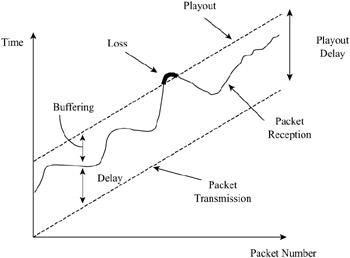6. Playout Buffer for Overcoming Delay Jitter
6. Playout Buffer for Overcoming Delay Jitter
It is common for streaming media clients to have a 5 to 15 second buffering before playback starts. As we have seen in Section 4, streaming can be viewed as a sequence of constraints for individual media samples. The use of buffering essentially relaxes all the constraints by an identical amount. Critical to the performance of streaming systems over best-effort networks such as the Internet, buffering provides a number of important advantages:
-
Jitter reduction: Variations in network conditions cause the time it takes for packets to travel between identical end-hosts to vary. Such variations can be due to a number of possible causes, including queuing delays and link-level retransmissions. Jitter can cause jerkiness in playback due to the failure of same samples to meet their presentation deadlines, and have to be therefore skipped or delayed. The use of buffering effectively extends the presentation deadlines for all media samples, and in most cases, practically eliminates playback jerkiness due to delay jitter. The benefits of a playback buffer are illustrated in Figure 34.2, where packets are transmitted and played at a constant rate, and the playback buffer reduces the number of packets that arrive after their playback deadline.

Figure 34.2: Effect of playout buffer on reducing the number of late packets. -
Error recovery through retransmissions: The extended presentation deadlines for the media samples allow retransmission to take place when packets are lost, e.g., when UDP is used in place of TCP for transport. Since compressed media streams are often sensitive to errors, the ability to recover losses greatly improves streaming media quality.
-
Error resilience through Interleaving: Losses in some media streams, especially audio, can often be better concealed if the losses are isolated instead of concentrated. The extended presentation deadlines with the use of buffering allow interleaving to transform possible burst loss in the channel into isolated losses, thereby enhancing the concealment of the subsequent losses. As we shall discuss in the next section, the extended deadlines also allow other forms of error control schemes such as the use of error control codes, which are particularly effective when used with interleaving.
-
Smoothing throughput fluctuation: Since a time-varying channel gives rise to time varying throughput, the buffer can provide needed data to sustain streaming when throughput is low. This is especially important when streaming is performed using TCP (or HTTP), since the server typically does not react to a drop in channel throughput by reducing media rate.
The benefits of buffering do come at a price though. Besides additional storage requirements at the streaming client, buffering also introduces additional delay before playback can begin or resume (after a pause due to buffer depletion). Adaptive Media Playout (AMP) is a new technique that enables a valuable tradeoff between delay and reliability [25,4].
EAN: 2147483647
Pages: 393